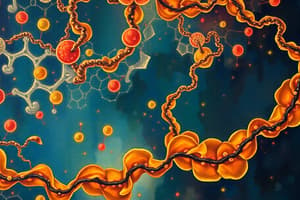Podcast
Questions and Answers
What is the process called when an amino acid is converted to an alpha-keto acid, which can then be used to synthesize another amino acid?
What is the process called when an amino acid is converted to an alpha-keto acid, which can then be used to synthesize another amino acid?
- Reductive Amination
- Transamination (correct)
- Deamination
- Decarboxylation
What is the result of the breakdown of an amino acid through deamination?
What is the result of the breakdown of an amino acid through deamination?
- An alpha-keto acid only
- An alpha-keto acid and an amine (correct)
- An amine and a carboxyl group
- An alpha-keto acid and a carboxyl group
What is the purpose of the urea cycle in amino acid metabolism?
What is the purpose of the urea cycle in amino acid metabolism?
- To regulate enzyme activity
- To break down amino acids
- To synthesize new amino acids
- To convert ammonia to urea for excretion (correct)
What is the term for the continuous breakdown and synthesis of proteins, which allows for the recycling of amino acids?
What is the term for the continuous breakdown and synthesis of proteins, which allows for the recycling of amino acids?
What is the term for the regulation of enzyme activity through binding of molecules to specific sites on the enzyme?
What is the term for the regulation of enzyme activity through binding of molecules to specific sites on the enzyme?
What is an example of a genetic disorder affecting amino acid metabolism?
What is an example of a genetic disorder affecting amino acid metabolism?
What is the term for the production of amino acids from glucose, pyruvate, or other non-amino acid precursors?
What is the term for the production of amino acids from glucose, pyruvate, or other non-amino acid precursors?
What is the term for the inhibition of an enzyme by the end product of a metabolic pathway?
What is the term for the inhibition of an enzyme by the end product of a metabolic pathway?
Flashcards are hidden until you start studying
Study Notes
Overview of Amino Acid Metabolism
Amino acid metabolism refers to the process by which cells synthesize, break down, and recycle amino acids, the building blocks of proteins.
Synthesis of Amino Acids
- Transamination: the conversion of an amino acid to an alpha-keto acid, which can then be used to synthesize another amino acid
- De Novo Synthesis: the production of amino acids from glucose, pyruvate, or other non-amino acid precursors
- Reductive Amination: the reduction of an alpha-keto acid to form an amino acid
Breakdown of Amino Acids
- Deamination: the removal of an amino group from an amino acid, resulting in an alpha-keto acid
- Decarboxylation: the removal of a carboxyl group from an amino acid, resulting in an amine
- Transdeamination: the transfer of an amino group from one amino acid to another
Regulation of Amino Acid Metabolism
- Feedback Inhibition: the inhibition of an enzyme by the end product of a metabolic pathway
- Allosteric Regulation: the regulation of enzyme activity through binding of molecules to specific sites on the enzyme
- Hormonal Regulation: the regulation of amino acid metabolism by hormones such as insulin and glucagon
Recycling of Amino Acids
- Urea Cycle: the conversion of ammonia to urea, which is then excreted
- Transamination: the conversion of an amino acid to an alpha-keto acid, which can then be reused to synthesize another amino acid
- Protein Turnover: the continuous breakdown and synthesis of proteins, which allows for the recycling of amino acids
Clinical Significance of Amino Acid Metabolism
- Inborn Errors of Metabolism: genetic disorders affecting amino acid metabolism, such as phenylketonuria and maple syrup urine disease
- Amino Acid Imbalance: an imbalance of amino acids in the diet, which can lead to various health problems
- Disease States: altered amino acid metabolism in diseases such as diabetes, cancer, and liver disease
Amino Acid Metabolism Overview
- Amino acid metabolism is a process by which cells synthesize, break down, and recycle amino acids, the building blocks of proteins.
Synthesis of Amino Acids
- Transamination involves converting an amino acid to an alpha-keto acid, which can then be used to synthesize another amino acid.
- De Novo Synthesis produces amino acids from glucose, pyruvate, or other non-amino acid precursors.
- Reductive Amination reduces an alpha-keto acid to form an amino acid.
Breakdown of Amino Acids
- Deamination removes an amino group from an amino acid, resulting in an alpha-keto acid.
- Decarboxylation removes a carboxyl group from an amino acid, resulting in an amine.
- Transdeamination transfers an amino group from one amino acid to another.
Regulation of Amino Acid Metabolism
- Feedback Inhibition occurs when an enzyme is inhibited by the end product of a metabolic pathway.
- Allosteric Regulation regulates enzyme activity through binding of molecules to specific sites on the enzyme.
- Hormonal Regulation regulates amino acid metabolism through hormones such as insulin and glucagon.
Recycling of Amino Acids
- The Urea Cycle converts ammonia to urea, which is then excreted.
- Transamination converts an amino acid to an alpha-keto acid, which can then be reused to synthesize another amino acid.
- Protein Turnover involves the continuous breakdown and synthesis of proteins, allowing for the recycling of amino acids.
Clinical Significance of Amino Acid Metabolism
- Inborn Errors of Metabolism are genetic disorders affecting amino acid metabolism, such as phenylketonuria and maple syrup urine disease.
- Amino Acid Imbalance occurs when there is an imbalance of amino acids in the diet, leading to various health problems.
- Disease States involve altered amino acid metabolism in diseases such as diabetes, cancer, and liver disease.
Studying That Suits You
Use AI to generate personalized quizzes and flashcards to suit your learning preferences.




